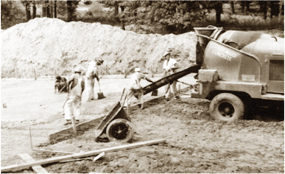
Many sorts of admixtures are accessible on the lookout, and they are gathered into different classifications like:
Usefulness Enhancing Agents
Typically concrete necessities water just 0.24-0.26 times the heaviness of concrete for hydration, yet by and large to get the expected functionality 0.4 to 0.6 times the heaviness of ready mix concrete bexley is added, which then diminishes the strength of the concrete. Thus, to further develop usefulness by different means, a few admixtures are liked, and they are:
Air-entraining specialists:

These admixtures incorporate regular wood tars, creature and vegetable oils, and sulfonated natural mixtures and give better protection from the activity of ice.
Finely separated minerals:
Admixtures like finely partitioned regular concrete, lime, and intensity treated earth are added to concrete to improve usefulness which lessens in dying.
Plasticizers:
These are synthetic substances, which bring sudsy activity in with the general mish-mash and are surface-dynamic as it were. Most normal sorts are benzene sulphonate and lignosulphonate corrosive, which decreases water necessity by 8-15 percent.
Superplasticizers:
These are fundamental admixtures to create extremely high-strength concrete and are utilized in prepared blended and self-compacting concrete. These synthetics are electrochemically dynamic and lessen the water-concrete proportion by 30%.
Gas pedals
These admixtures are added to concrete to speed up setting time. Gas pedals like calcium chloride are added as admixtures 1-2 percent to get solidified concrete inside a few minutes. For RCC, and Portland slag concrete (PSC) works, calcium formate might be utilized for fast setting of concrete and are utilized for street fixes and to stop spillages because of breaks.
The presence of chloride is destructive to steel and ought to be utilized exclusively in plain concrete and shouldn’t surpass 1.5 percent of the heaviness of concrete.
Retarders
These admixtures are utilized to defer the setting of concrete. Calcium sulfate is the ordinarily utilized retarder and utilized in prepared blended concrete when it must be moved to far-off places in the wake of being blended.
Mineral Admixtures
They lessen warm breaking and further develop strength, impermeability, and solidness. A portion of the mineral admixtures are utilized to work on specific characteristics in concrete, and they are
Fly debris:
Using fly debris guarantees uniform mixing with concrete.
Silica rage:
It is an exceptionally fine non-translucent silicon dioxide and goes about as a magnificent pore-filling material.
Rice husk debris:
This is a profoundly responsive admixture used to get the necessary presentation and consistency qualities.
Metakaolin:
It is utilized as a pozzolanic material in concrete.
Fabulous granular impact heater slag:
It is a byproduct of the development of steel. Particles of under 10 µm add to early strength while particles of the size 10-45 µm add to the strength in later age. Particles of a size more prominent than 45 µm ought not to be utilized, as they don’t by and large hydrate.
Waterproofers
Utilization of overabundance of water in concrete for hydration will in general shape narrow pores in solidified concrete. A few reasonable synthetic compounds are added to concrete or mortar at the hour of production to make the construction waterproof. Waterproofing is accomplished by following at least one blends
- Hindering vessels by creating precious stones
- Compression of slim pores
- Creating water-repulsing slim powers because of the hydrophobic impact
- Various Admixtures
- Shades: Pigments like mineral dark, earthy colored iron oxide, yellow iron oxide, and red iron oxide are added to get hued concrete.
Broad synthetics:
These admixtures are added to cause concrete to grow while setting and synthetics utilized are hydrogen peroxide and metallic aluminum.
Erosion opposing synthetics:
These synthetic compounds are added to work on the opposition of fortifications to consumption.
Antifungal admixtures:
The addition of copper compounds, polyhalogenated phenol, and dieldrin emulsion forestalls the development of microbes on the surfaces of the concrete.